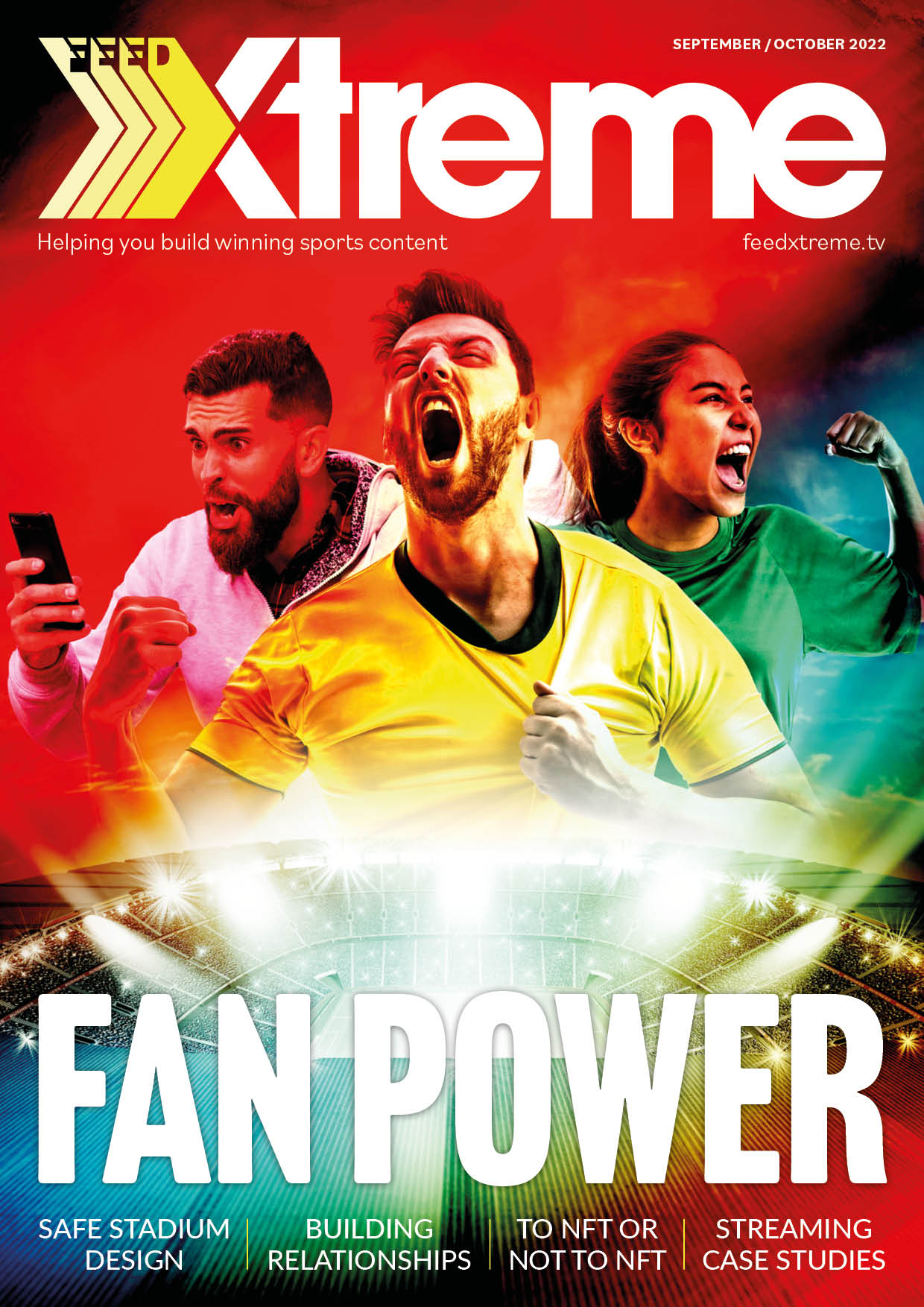CS:GO strikes back – in 4K!

Posted on Jul 29, 2022 by FEED Staff
PGL Major Stockholm 2021 saw unprecedented viewership for CS:GO – and a groundbreaking 4K workflow. FEED tools up to go behind the scenes
Words by Michael Burns
Esports are back. Big time. PGL Major Stockholm 2021, which took place in November, was the first significant championship after two years of isolation – and the only recent elite esports tournament to have a live audience. The competition became the most successful Counter-Strike: Global Offensive (CS:GO) event ever, with peak viewing numbers exceeding 2.74 million, more than double the previous record. The major boosted Twitch’s CS:GO category to fifth place, and sits in seventh place in Twitch’s top ten most popular esports events in history, according to escharts.com.
PGL Major Stockholm 2021, the 16th such championship, was also the first Counter-Strike major broadcast in 4K. With viewers enjoying over 120 hours of the objective-based, multiplayer FPS action, the behind-the-scenes operation was a tournament effort in itself. Not only did the organiser, PGL, need to fly all the qualified players into Sweden – and entertain a large number of spectators inside Stockholm’s iconic Avicii Arena – but bringing the LAN event live to the world threw up a host of challenges for PGL and its broadcast partners.
PGL Major Stockholm 2021 saw unprecedented viewership for CS:GO – and a groundbreaking 4K workflow. FEED tools up to go behind the scenes
Words by Michael Burns
Esports are back. Big time. PGL Major Stockholm 2021, which took place in November, was the first significant championship after two years of isolation – and the only recent elite esports tournament to have a live audience. The competition became the most successful Counter-Strike: Global Offensive (CS:GO) event ever, with peak viewing numbers exceeding 2.74 million, more than double the previous record. The major boosted Twitch’s CS:GO category to fifth place, and sits in seventh place in Twitch’s top ten most popular esports events in history, according to escharts.com.
PGL Major Stockholm 2021, the 16th such championship, was also the first Counter-Strike major broadcast in 4K. With viewers enjoying over 120 hours of the objective-based, multiplayer FPS action, the behind-the-scenes operation was a tournament effort in itself. Not only did the organiser, PGL, need to fly all the qualified players into Sweden – and entertain a large number of spectators inside Stockholm’s iconic Avicii Arena – but bringing the LAN event live to the world threw up a host of challenges for PGL and its broadcast partners.
Building back, bigger
“When we heard we would be hosting the first CS:GO major after the lockdown period, we started wondering how to make all the waiting worthwhile,” says Silviu Stroie, CEO of PGL. “Both us and the fans were hungry for some CS:GO, and we wanted to give them a major they would remember for years to come. The plan was to keep it simple and focus on the games.
“We aimed to bring the event back to Sweden, a country with a ton of history in Counter-Strike, and to have it hosted by an iconic panel line-up,” Stroie continues. “Add a touch of 4K, so both online and offline viewers see all the action crisp and clear – then just let the players and crowd enjoy the game as it should be.”
With a prize pool set at $2m – the largest in CS:GO history – PGL Major Stockholm 2021 was the first significant event in the world of CS:GO esports, with spectators in attendance, since the beginning of the pandemic. Teams from across the globe (24 in total, comprising 120 players) qualified in three different tiers; headliners included Ninjas in Pyjamas, Team Vitality and Evil Geniuses. From 26 October to 7 November, the Challengers, Legends and Champions Stages (the playoffs) ran over four days each. The final, in which Natus Vincere (Navi) conquered G2 Esports, became the most popular match in the history of CS:GO. At the peak of the broadcast, it was watched by 2,748,850 spectators.
However, as Stroie observes, things don’t always go exactly to plan.
“Circumstances beyond our control led to a Challengers/Legends stage where the panel could not be in the same arena in Stockholm. While preparing an epic final stage in the venue, we used virtual sets for both panel and casters, running the Challengers and Legends from our studios in Bucharest, Romania. At the same time, the games were being played in Sweden. The global situation imposed by the pandemic meant many measures had to be taken to protect the health and
safety of players, talent and staff.
“This brought many other new challenges, but thanks to our team’s hard work and dedication, the show went on, delivering what everybody was waiting for – a fantastic Counter-Strike experience.”
Building back, bigger
“When we heard we would be hosting the first CS:GO major after the lockdown period, we started wondering how to make all the waiting worthwhile,” says Silviu Stroie, CEO of PGL. “Both us and the fans were hungry for some CS:GO, and we wanted to give them a major they would remember for years to come. The plan was to keep it simple and focus on the games.
“We aimed to bring the event back to Sweden, a country with a ton of history in Counter-Strike, and to have it hosted by an iconic panel line-up,” Stroie continues. “Add a touch of 4K, so both online and offline viewers see all the action crisp and clear – then just let the players and crowd enjoy the game as it should be.”
With a prize pool set at $2m – the largest in CS:GO history – PGL Major Stockholm 2021 was the first significant event in the world of CS:GO esports, with spectators in attendance, since the beginning of the pandemic. Teams from across the globe (24 in total, comprising 120 players) qualified in three different tiers; headliners included Ninjas in Pyjamas, Team Vitality and Evil Geniuses. From 26 October to 7 November, the Challengers, Legends and Champions Stages (the playoffs) ran over four days each. The final, in which Natus Vincere (Navi) conquered G2 Esports, became the most popular match in the history of CS:GO. At the peak of the broadcast, it was watched by 2,748,850 spectators.
However, as Stroie observes, things don’t always go exactly to plan.
“Circumstances beyond our control led to a Challengers/Legends stage where the panel could not be in the same arena in Stockholm. While preparing an epic final stage in the venue, we used virtual sets for both panel and casters, running the Challengers and Legends from our studios in Bucharest, Romania. At the same time, the games were being played in Sweden. The global situation imposed by the pandemic meant many measures had to be taken to protect the health and
safety of players, talent and staff.
“This brought many other new challenges, but thanks to our team’s hard work and dedication, the show went on, delivering what everybody was waiting for – a fantastic Counter-Strike experience.”


International tournament
“Viewers had the chance to watch the final product on streaming platforms such as YouTube, Twitch and SteamTV,” continues Stroie. “It is a complex process, and each tiny piece can be decisive, so everything needs to be well-calibrated to deliver a good result.”
The goal was to reach “every CS:GO fan in every corner of the world”, as well as officially broadcast the tournament in 25 languages. To achieve this ambitious goal, PGL enlisted the help of independent producer, and sports and entertainment distributor, IMG.
“In the past, we’ve distributed CS:GO majors for PGL and ELeague, and other esports events such as the Fortnite World Cup,” says IMG commercial manager Joe Jenkins. “This, in particular, felt different. It’s the first CS:GO major for two years and the highest prize pool ever – the biggest major to date. There was huge appetite and excitement for this among the community and our broadcast partners.”
These included TV 2 Denmark, TV 2 Norway, Sýn hf, Perfect World, Gaules, Fantasyexpo and WePlay. Coverage could be found on OTT, on-demand esports channels, dedicated gaming platforms like Twitch and Nimo TV, plus YouTube and Facebook.
“We work closely with IMG Media global sales resources in key and emerging esports markets,” says Jenkins. “Each one has a unique esports media landscape, and we lean on their expertise to create the perfect strategy for ensuring maximum distribution.”
Languages supported among the territories ranged from Russian, Romanian and Icelandic, to Filipino, Chinese, Vietnamese and Malay.
“We use our sales and account management team in each market. They’re experts in the local language, and offer the support needed with broadcast partners.”
International tournament
“Viewers had the chance to watch the final product on streaming platforms such as YouTube, Twitch and SteamTV,” continues Stroie. “It is a complex process, and each tiny piece can be decisive, so everything needs to be well-calibrated to deliver a good result.”
The goal was to reach “every CS:GO fan in every corner of the world”, as well as officially broadcast the tournament in 25 languages. To achieve this ambitious goal, PGL enlisted the help of independent producer, and sports and entertainment distributor, IMG.
“In the past, we’ve distributed CS:GO majors for PGL and ELeague, and other esports events such as the Fortnite World Cup,” says IMG commercial manager Joe Jenkins. “This, in particular, felt different. It’s the first CS:GO major for two years and the highest prize pool ever – the biggest major to date. There was huge appetite and excitement for this among the community and our broadcast partners.”
These included TV 2 Denmark, TV 2 Norway, Sýn hf, Perfect World, Gaules, Fantasyexpo and WePlay. Coverage could be found on OTT, on-demand esports channels, dedicated gaming platforms like Twitch and Nimo TV, plus YouTube and Facebook.
“We work closely with IMG Media global sales resources in key and emerging esports markets,” says Jenkins. “Each one has a unique esports media landscape, and we lean on their expertise to create the perfect strategy for ensuring maximum distribution.”
Languages supported among the territories ranged from Russian, Romanian and Icelandic, to Filipino, Chinese, Vietnamese and Malay.
“We use our sales and account management team in each market. They’re experts in the local language, and offer the support needed with broadcast partners.”


Full-spectrum warfare
In the arena, the coverage rivalled top-flight football, with 21 camera operators and over 15 cameras.
“Cutting-edge 4K cameras of various brands helped deliver spectacular, crisp, innovative shots,” says Stroie. “We had static broadcast cameras, Steadicams, individual player cameras, jibs and drones. As a video switcher, we used Blackmagic’s Atem Constellation 8K – and, to deliver the best experience possible, a mix of open-source (OBS Studio) and commercial (vMix) software. For an esports tournament, having excellent latency is decisive. To obtain this, we used ultra low-latency switches and minimised signal path.”
In addition, VoIP and AoIP were served up using NDI 5 and Dante protocols, respectively.
PGL wanted to enrich viewer experience by having the panel in a virtual set, based on a remixed version of the B site in Dust2 – an iconic map from CS:GO. “The cyberpunk theme was chosen by our art team,” Stroie explains. “In-game AR features enriched the freeze time between rounds by showing statistics about different players.”
PGL Major Stockholm 2021 was the first CS:GO major broadcast in 4K, but wasn’t the organisation’s first 4K tournament. “The industry standard right now is for 1080p broadcast, but CS:GO is a fast-paced game. The improvement in video quality boosts the viewing experience,” says Stroie. “Fans are increasingly demanding; they watch the games on big screens, and every pixel is important. Our 4K stream on YouTube went viral – people enjoyed every second of the tournament.”
When you realise the audience watched over 71,269,601 hours in total, with an average of 593,060 viewers tuned in at any one time, that’s a lot of enjoyment.
This article first featured in the Winter 2021 issue of FEED.
Gaming and Esports archives
Full-spectrum warfare
In the arena, the coverage rivalled top-flight football, with 21 camera operators and over 15 cameras.
“Cutting-edge 4K cameras of various brands helped deliver spectacular, crisp, innovative shots,” says Stroie. “We had static broadcast cameras, Steadicams, individual player cameras, jibs and drones. As a video switcher, we used Blackmagic’s Atem Constellation 8K – and, to deliver the best experience possible, a mix of open-source (OBS Studio) and commercial (vMix) software. For an esports tournament, having excellent latency is decisive. To obtain this, we used ultra low-latency switches and minimised signal path.”
In addition, VoIP and AoIP were served up using NDI 5 and Dante protocols, respectively.
PGL wanted to enrich viewer experience by having the panel in a virtual set, based on a remixed version of the B site in Dust2 – an iconic map from CS:GO. “The cyberpunk theme was chosen by our art team,” Stroie explains. “In-game AR features enriched the freeze time between rounds by showing statistics about different players.”
PGL Major Stockholm 2021 was the first CS:GO major broadcast in 4K, but wasn’t the organisation’s first 4K tournament. “The industry standard right now is for 1080p broadcast, but CS:GO is a fast-paced game. The improvement in video quality boosts the viewing experience,” says Stroie. “Fans are increasingly demanding; they watch the games on big screens, and every pixel is important. Our 4K stream on YouTube went viral – people enjoyed every second of the tournament.”
When you realise the audience watched over 71,269,601 hours in total, with an average of 593,060 viewers tuned in at any one time, that’s a lot of enjoyment.
This article first featured in the Winter 2021 issue of FEED.
Gaming and Esports archives



